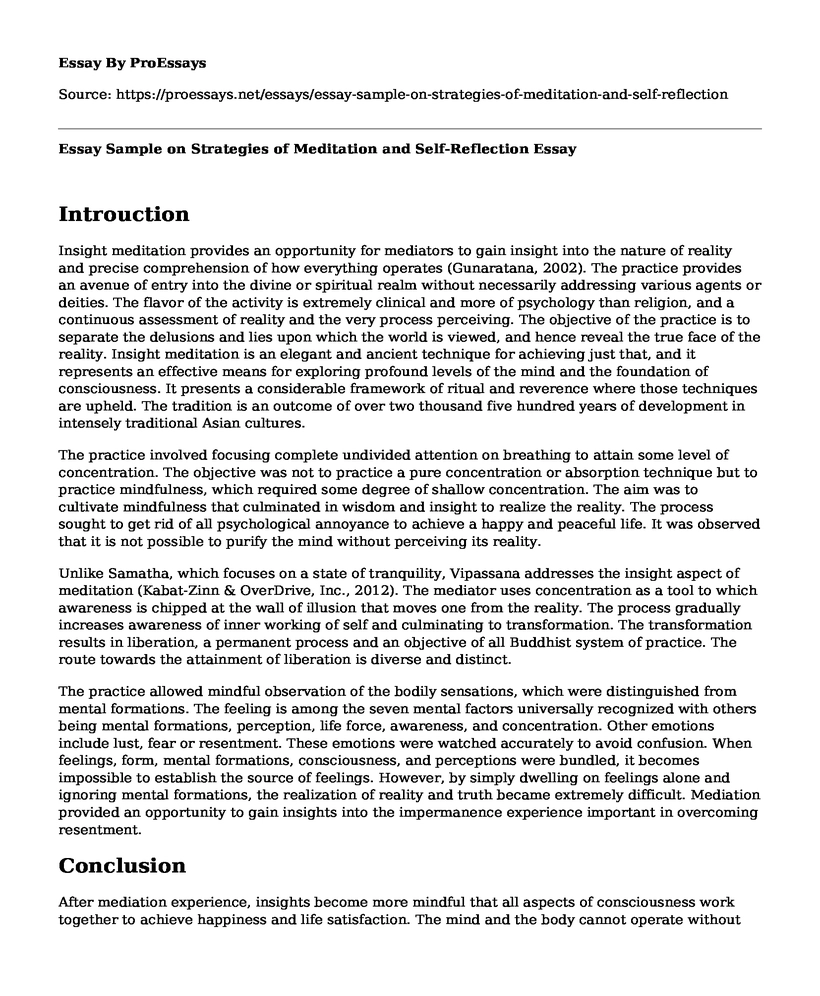Introuction
Insight meditation provides an opportunity for mediators to gain insight into the nature of reality and precise comprehension of how everything operates (Gunaratana, 2002). The practice provides an avenue of entry into the divine or spiritual realm without necessarily addressing various agents or deities. The flavor of the activity is extremely clinical and more of psychology than religion, and a continuous assessment of reality and the very process perceiving. The objective of the practice is to separate the delusions and lies upon which the world is viewed, and hence reveal the true face of the reality. Insight meditation is an elegant and ancient technique for achieving just that, and it represents an effective means for exploring profound levels of the mind and the foundation of consciousness. It presents a considerable framework of ritual and reverence where those techniques are upheld. The tradition is an outcome of over two thousand five hundred years of development in intensely traditional Asian cultures.
The practice involved focusing complete undivided attention on breathing to attain some level of concentration. The objective was not to practice a pure concentration or absorption technique but to practice mindfulness, which required some degree of shallow concentration. The aim was to cultivate mindfulness that culminated in wisdom and insight to realize the reality. The process sought to get rid of all psychological annoyance to achieve a happy and peaceful life. It was observed that it is not possible to purify the mind without perceiving its reality.
Unlike Samatha, which focuses on a state of tranquility, Vipassana addresses the insight aspect of meditation (Kabat-Zinn & OverDrive, Inc., 2012). The mediator uses concentration as a tool to which awareness is chipped at the wall of illusion that moves one from the reality. The process gradually increases awareness of inner working of self and culminating to transformation. The transformation results in liberation, a permanent process and an objective of all Buddhist system of practice. The route towards the attainment of liberation is diverse and distinct.
The practice allowed mindful observation of the bodily sensations, which were distinguished from mental formations. The feeling is among the seven mental factors universally recognized with others being mental formations, perception, life force, awareness, and concentration. Other emotions include lust, fear or resentment. These emotions were watched accurately to avoid confusion. When feelings, form, mental formations, consciousness, and perceptions were bundled, it becomes impossible to establish the source of feelings. However, by simply dwelling on feelings alone and ignoring mental formations, the realization of reality and truth became extremely difficult. Mediation provided an opportunity to gain insights into the impermanence experience important in overcoming resentment.
Conclusion
After mediation experience, insights become more mindful that all aspects of consciousness work together to achieve happiness and life satisfaction. The mind and the body cannot operate without each other and meditation allows us to establish their interactions. Therefore, mediation provided an opportunity to apply mindfulness to the daily life to tackle overseen eventualities. These eventualities occur due to multiple causes and conditions considering the impermanent and conditional nature of the world. As such mediation fosters mindfulness, which acts as the emergency kit to address such concerns. When confronted with a feeling of indignation, people are compelled to reevaluate their mind and establish the harsh truths. Although a bitter truth, the discovery is the most rewarding experience of the mediation process.
References
Kabat-Zinn, J., & OverDrive, Inc. (2012). Mindfulness for beginners: Reclaiming the present
moment--and your life. Boulder, CO: Sounds True.
Gunaratana, B. H. (2002). Mindfulness in plain English. Singapore: Buddhist Research Society.
Cite this page
Essay Sample on Strategies of Meditation and Self-Reflection. (2022, Oct 18). Retrieved from https://proessays.net/essays/essay-sample-on-strategies-of-meditation-and-self-reflection
If you are the original author of this essay and no longer wish to have it published on the ProEssays website, please click below to request its removal:
- Maladaptive Behavior Case Study
- Existential Therapy Essay Example
- Essay Example on Soft Skills: Key to Managing Change Effectively
- Mental Health Counselor: Understanding Clients to Improve Their Lives - Essay Sample
- Article Analysis Essay on Complicated Grief
- Paper Example on Understanding Addicts: Educate Yourself to Help a Loved One
- Developing Employability Skills: A Self-Assessment for the Role of Voluntary Witness Support Worker







